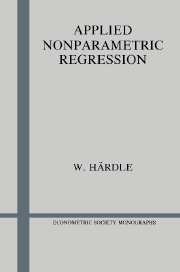Book contents
- Frontmatter
- PART I Regression smoothing
- PART II The kernel method
- 4 How close is the smooth to the true curve?
- 5 Choosing the smoothing parameter
- 6 Data sets with outliers
- 7 Nonparametric regression techniques for correlated data
- 8 Looking for special features and qualitative smoothing
- 9 Incorporating parametric components
- PART III Smoothing in high dimensions
- Appendix 1
- Appendix 2
- References
- Name Index
- Subject Index
6 - Data sets with outliers
from PART II - The kernel method
Published online by Cambridge University Press: 05 January 2013
- Frontmatter
- PART I Regression smoothing
- PART II The kernel method
- 4 How close is the smooth to the true curve?
- 5 Choosing the smoothing parameter
- 6 Data sets with outliers
- 7 Nonparametric regression techniques for correlated data
- 8 Looking for special features and qualitative smoothing
- 9 Incorporating parametric components
- PART III Smoothing in high dimensions
- Appendix 1
- Appendix 2
- References
- Name Index
- Subject Index
Summary
In exploratory data analysis one might wish instead to discover patterns while making few assumptions about data structure, using techniques with properties that change only gradually across a wide range of noise distributions. Nonlinear data smoothers provide a practical method of finding general smooth patterns for sequenced data confounded with long-tailed noise.
P. Velleman (1980, p. 609)Suppose that one observes data such as those in Figure 6.1: the main body of the data lies in a strip around zero and a few observations, governing the scaling of the scatter plot, lie apart from this region. These few data points are obviously outliers. This terminology does not mean that outliers are not part of the joint distribution of the data or that they contain no information for estimating the regression curve. It means rather that outliers look as if they are too small a fraction of the data to be allowed to dominate the small-sample behavior of the statistics to be calculated. Any smoother (based on local averages) applied to data like that in Figure 6.1 will exhibit a tendency to “follow the outlying observations.” Methods for handling data sets with outliers are called robust or resistant.
From a data-analytic viewpoint, a nonrobust behavior of the smoother is sometimes undesirable. Suppose that, a posteriori, a parametric model for the response curve is to be postulated. Any erratic behavior of the nonparametric pilot estimate will cause biased parametric formulations. Imagine, for example, a situation in which an outlier has not been identified and the nonparametric smoothing method has produced a slight peak in the neighborhood of that outlier. A parametric model which fitted that “nonexisting” peak would be too high-dimensional.
Information
- Type
- Chapter
- Information
- Applied Nonparametric Regression , pp. 190 - 202Publisher: Cambridge University PressPrint publication year: 1990
Accessibility standard: Unknown
Why this information is here
This section outlines the accessibility features of this content - including support for screen readers, full keyboard navigation and high-contrast display options. This may not be relevant for you.Accessibility Information
- 1
- Cited by
